Reptile & Amphibian
News Blog
Keep up with news and features of interest to the reptile and amphibian community on the kingsnake.com blog. We cover breaking stories from the mainstream and scientific media, user-submitted photos and videos, and feature articles and photos by Jeff Barringer, Richard Bartlett, and other herpetologists and herpetoculturists.
Thursday, January 31 2019
We are LOVING this motley snow Boa Constrictor in our Herp Photo of the day, uploaded by kingsnake.com user Sharkman20 ! Be sure to tell them you liked it here!

Upload your own reptile and amphibian photos at gallery.kingsnake.com, and you could see them featured here!
Wednesday, January 30 2019
Amazon Tree Boas are some of the most photogenic snakes in our world, like this one in our Herp Photo of the day, uploaded by kingsnake.com user BPruett , always perfectly posed! Be sure to tell them you liked it here!

Upload your own reptile and amphibian photos at gallery.kingsnake.com, and you could see them featured here!
Tuesday, January 29 2019
What a great looking pair of Australian water dragons in our herp photo of the day, uploaded by kingsnake.com user cochran! Be sure to tell them you liked it here!

Upload your own reptile and amphibian photos at gallery.kingsnake.com, and you could see them featured here!
Monday, January 28 2019
This hatching Cribo in our herp photo of the day, uploaded by kingsnake.com user alanB makes monday more bearable! Be sure to tell them you liked it here!

Upload your own and photos at gallery.kingsnake.com, and you could see them featured here!
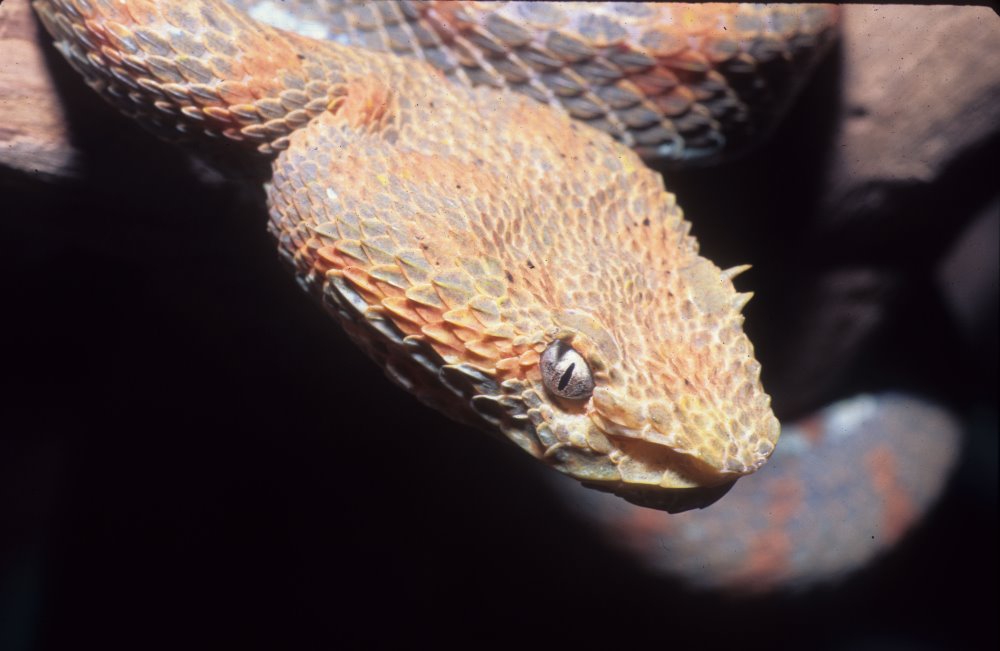
Coloration alone indicated that this snake was Bothriechis supraciliaris.
This occurred in those “good old days,” in the days when, believe it or not, snakes (including this one, but usually baby boas), mouse opossums, tarantulas, and other creatures were imported by accident in shipments of fruit and especially in bananas. This snake arrived with bananas at a fruit vendor in Boston in the early 50s and rather than killing it the Boston Museum of Science was notified. The snake was gathered in due haste by researchers from the Museum’s Herp Dept.
Back then it was identified as an eyelash viper, Bothrops (now Bothriechis schlegelii (this was 1954, the same year that B. supraciliaris, the blotched palm viper was described, but back then very few folks knew of the existence of the latter). For reasons that were unknown to me then and remain so today, rather than being preserved the snake was maintained in the live collection and when a year or so later I saw the beautiful snake and got excited about its existence it was given to me. I kept it for years, photographed it (as best I could in those days) and after its death the snake was disposed of in a now forgotten manner. From time to time I have published its photo. For years nothing was said, but in recent years I have been told that the snake, rather than a schlegelii was a supraciliaris. Others steadfastly maintained it was a schlegelii.
Nothing remains of this snake but its old photos. Its identification has not really been settled. Although I’ll probably never know for certain, Just for the record, I have since seen snakes that were very similar to my questionable snake, and that were definitely supraciliaris. I’m still leaning in that direction and always shall.
Continue reading "It’s a What?"
Friday, January 25 2019
Happy Rattlesnake Friday! Here's lookin' at you kid! Check out this gorgeous albino Southern Pacific Rattlesnake in our herp photo of the day uploaded by kingsnake.com user lichanura . Be sure to tell them you liked it here!

Upload your own reptile and amphibian photos at gallery.kingsnake.com, and you could see them featured here!
Thursday, January 24 2019
What a cute lil Punkin! Loving this gorgeous shot of a young Tokay Gecko in our Herp Photo of the day, uploaded by kingsnake.com user mfontenot ! Be sure to tell them you liked it here!

Upload your own reptile and amphibian photos photos at gallery.kingsnake.com, and you could see them featured here!
Wednesday, January 23 2019
Love this cage set up for this Arizona Mt. Kingsnake in our Herp Photo of the day, uploaded by kingsnake.com user rbichler !! Be sure to tell them you liked it here!

Upload your own reptile and amphibian photos at gallery.kingsnake.com, and you could see them featured here
Tuesday, January 22 2019
It's hatch day for this little Hognose in our Herp Photo of the day, uploaded by kingsnake.com user motorhead !! Be sure to tell them you liked it here!

Upload your own reptile and amphibian photos at gallery.kingsnake.com, and you could see them featured here
Monday, January 21 2019
This young banded water snake being very curious in our herp photo of the day, uploaded by kingsnake.com user casichelydia ! Be sure to tell them you liked it here!

Upload your own and photos at gallery.kingsnake.com, and you could see them featured here!
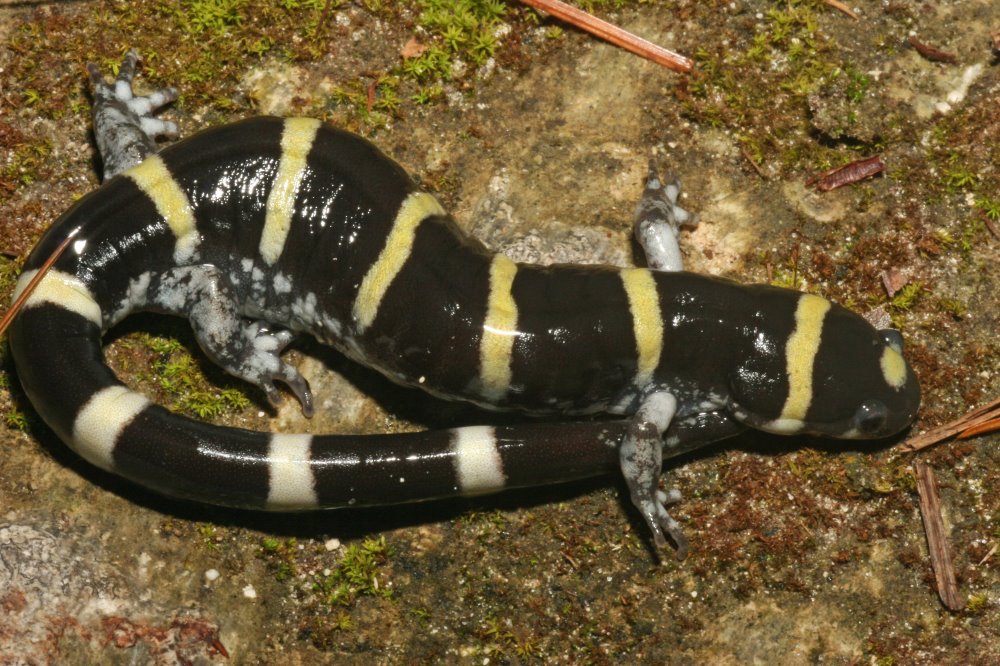
This is a typically marked adult ringed salamanderJake and I were recently back in southwestern Arkansas on, as might be expected, a herping foray. Ever since Jake had learned of this salamanders existence, he had told me time and again, he had been enamored of the beauty of the ringed salamander, Ambystoma annulatum, and although we had been in the region where they were found on previous trips, neither weather conditions nor season, had been conducive for these aptly named mole salamanders to have emerged from their burrows. So we had previously whiled away our time searching for and photographing some of the other Ozarkian caudatans.
But today, a cool autumn day, was different. It was raining and the rain was forecast to extend well into the coming hours of darkness. We had a few locales to check out before dark. All in all things were looking good. Necessary tedium first--motel, a bite to eat-- then into the mountains.
After bumping for several miles along a woodland dirt road we found ourselves in a land of rocks. This was definitely ringed salamander habitat—but there was a problem. Rock after rock, for as far as we could see, had been freshly turned out of its cradle and just left lying atop the leaves. We could only guess that this was the work of uncaring market hunters. For the first hour Jake and I rolled rocks back into their original positions. By then darkness was approaching and we discontinued the reconstruction efforts with hundreds of rocks still out of place. We did want to get a few minutes of salamander hunting in.
We walked a bit further to a small ephemeral pond and found after considerable searching Jake’s lifer ringed salamander and dozens (probably hundreds) of freshly laid eggs.
The rain continued making photographing difficult but not impossible and we were soon on the way back to the motel.
Once back to the paved road, the rain now barely a sprinkle, we were lucky enough to see another 4 ringed salamanders. Our trip was a resounding success.
Continue reading "Ringed Salamanders"
Sunday, January 20 2019

A profile of the beautiful white rattlesnake.
Can white be a camouflage color? It sure can when it is peppered with tiny black flecks of color and sitting atop or amidst a number of rocks that are similarly colored.
And is there any such place?
There surely is. And Jake and I were amidst those rocks right now—or actually, right then. It was late on a night late in August in Arizona and even at well past midnight the heat was radiating from those black speckled white rocks as we searched for our target, a black fleckled white speckled rattlesnake. “Speckled” is the name of this snake, Crotalus pyrrhus, as well as its color.
It was Jake who had decided on this target, the speckled rattler. Then he had added the specific color. Sounded good to me, and after all, the locale was only 2000+ miles away from our homes. Heck. What’s 2000+ miles to dedicated herpers. I had dragged Jake farther than that to see a single species of bird. And neither of us make any special claim to our birding prowess.
So after borrowing and loading Patti’s car for the trip, off we went. A day and a half later we arrived and were searching the habitat. 4 days later, after finding a fair number of great herps and groggy from lack of sleep, we realized we had failed to find the target and since we still had a few semi-target species—rock rattlers, regal horned lizards and a stop at the wonderful Arizona Sonora Desert Museum-- a few hundred miles to the east it was time to begin our multi-stopped retreat. Fortunately we were more successful on our list of semi-target taxa than we had been on the target.
Are we going to try again? You betcha! And the next time, in the famous last words of somebody (I think it was Jake!), “we shall succeed.”
But for now, Eastward-ho!
Continue reading "White Rattlesnakes"
Friday, January 18 2019
Happy Rattlesnake Friday! Yes, it isn't a Rattlesnake, but it is a venomous snake! The only snake as well known as a rattlesnake is a cobra, but not all cobras are made alike! Some stand out like this red eyed leucy Monocled Cobra in our photo of the day uploaded by kingsnake.com user eekster ! Be sure to tell them you liked it here! As always on Friday, we celebrate all of our venomous reptiles for their contribution to the world. It is our goal to help dispel the fears surrounding our beloved venomous creatures.

Upload your own reptile and amphibian photos at gallery.kingsnake.com, and you could see them featured here!
Thursday, January 17 2019
Here is to hoping this hatchling albino Siamese Crocodile our Herp Photo of the day, uploaded by kingsnake.com user crocodilepaul helps brighten your day!! Be sure to tell them you liked it here!

Upload your own reptile and amphibian photos at gallery.kingsnake.com, and you could see them
Wednesday, January 16 2019
Welcome to the world little one! That magical moment when a baby takes it's first breath is captured here with this boa in our Herp Photo of the day, uploaded by kingsnake.com user dpiscopo69 ! Be sure to tell them you liked it here!

Upload your own reptile and amphibian photos at gallery.kingsnake.com, and you could see them featured here!
Tuesday, January 15 2019
This Wood Frog in our herp photo of the day, brings back memories of summertime herping. Uploaded by kingsnake.com user casichelydia . Be sure to tell them you liked it here!

Upload your own reptile and amphibian photos photos at gallery.kingsnake.com, and you could see them featured here!
Monday, January 14 2019
So very underestimated but how many of you caught a Garter like the one in our Herp Photo of the day, uploaded by kingsnake.com user snakekate for your first field find? Be sure to tell them you liked it here!

Upload your own reptile and amphibian photos at gallery.kingsnake.com, and you could see them featured here!
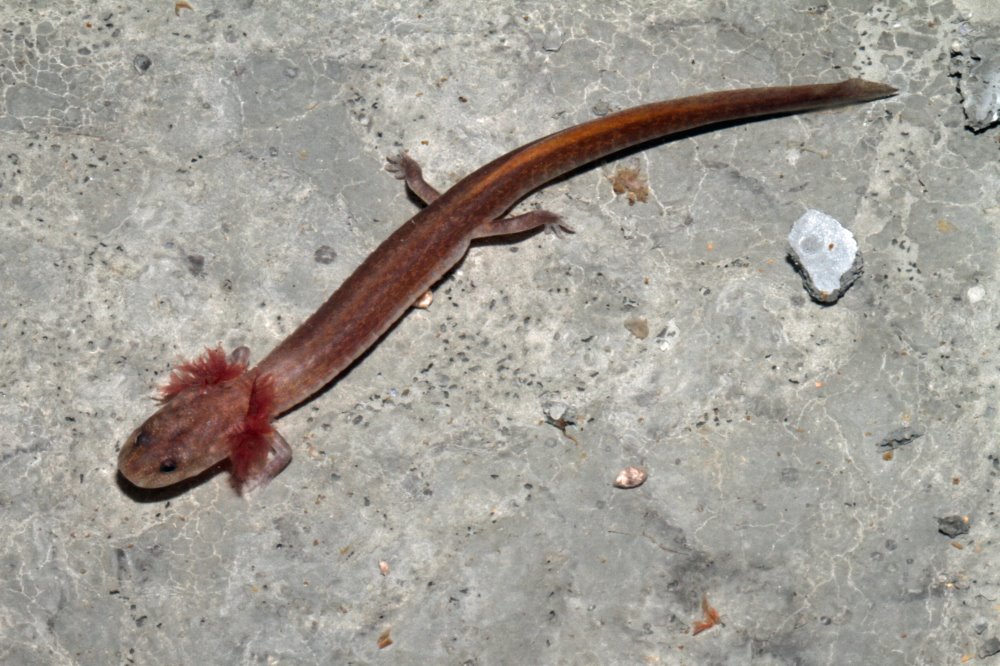
External gills, functional eyes, tailfin--the larval grotto salamander has all three.
Currently there are 191 named species of salamanders in the USA. This large amphibian grouping is contained in 8 families of which the largest by far is the Plethodontidae with 147 species plus well over a dozen subspecies. With the use of genetics it is probable that an additional 25+ species will soon be added to this family.
The plethodontids vary in size from 2” long dwarfs to what are considered in this family comparative giants of 9”. Among these are species that are entirely aquatic throughout their lives (paedomorphic taxa), others which are just as entirely terrestrial, and many that are in between these two extremes. Most seek seclusion beneath logs and rocks in damp woodlands, some prefer a similar microhabitat along stream edges, and others live beneath rocks and leaf litter submerged in streams, creeks, or rivulets. Terrestrial taxa have well developed, fully functional eyes, some aquatic forms have reduced vision, and some aquatics are blind. And then there’s the grotto salamander, Eurycea (formerly Typhlotriton) spelaea, a most remarkable little beast that may be encountered in the cave systems of Southeastern Kansas , Northeastern Oklahoma, Southern Missouri and Northern Arkansas.
Troglodytic when adult and in its later stages as a larva, after hatching the larvae often follow connecting underground streams from the darkness of caves to the daylight outside. At that point they are pigmented, being a weakly patterned olive brown to tan. They then have functional eyes, 3 pairs of external gills, and a well-developed tailfin. During the daylight hours they, like many aquatic salamanders, hide beneath rocks and stream bottom debris. On cloudy days and at night they are more inclined to depart their lairs, swimming and foraging in the open.
After a larval duration of several years the 3 or 4 inch long larvae follow their home streams back into the darkness and undergo a metamorphosis that is typical in some respects but atypical in others. Simplified, typically the gills and tailfin lessen in size and function until they are fully resorbed and the larvae become capable of existing terrestrially. Atypically the pigment of the now subterranean salamander is gradually lost and rather than becoming lidded and terrestrially functional as do the eyes of other plethodontids, the eyes of the grotto salamander degenerate and the lids fuse, producing at adulthood a pinkish, sightless, terrestrial, troglodyte.
Welcome to the wonderfully complex world of Mother Nature.
Continue reading "Grotto Salamander"
Friday, January 11 2019
Happy Rattlesnake Friday! What a great field find Copperhead from Brown County, Indiana in our Herp Photo of the day, uploaded by kingsnake.com user ReptileProducts ! Be sure to tell them you liked it here! As always on Friday, we celebrate all of our venomous reptiles for their contribution to the world, not just rattlesnakes. They all need our help to change misconceptions.

Upload your own reptile and amphibian photos at gallery.kingsnake.com, and you could see them featured here!
Thursday, January 10 2019
Love the darker phase of this greyband in our Herp Photo of the day, uploaded by kingsnake.com user trevid ! Be sure to tell them you liked it here!

Upload your own reptile and amphibian photos photos at gallery.kingsnake.com, and you could see them featured here!
Wednesday, January 9 2019
What an awesome shot of this pair of Common Toads in our herp photo of the day uploaded by kingsnake.com user Krallenfrosch ! Be sure to tell them you liked it here!

Upload your own reptile and amphibian photos at gallery.kingsnake.com, and you could see them featured here!
Tuesday, January 8 2019
This lovely Gila monster poses perfectly in our Herp Photo of the day, uploaded by kingsnake.com user vegasbilly ! Be sure to tell them you liked it here!

Upload your own reptile and amphibian photos photos at gallery.kingsnake.com, and you could see them featured here!
Monday, January 7 2019
What stunning colors on this male Sceloporus orcutti in our Herp Photo of the day, uploaded by kingsnake.com user eve. Be sure to tell them you liked it here!

Upload your own reptile and amphibian photos at gallery.kingsnake.com, and you could see them featured here!
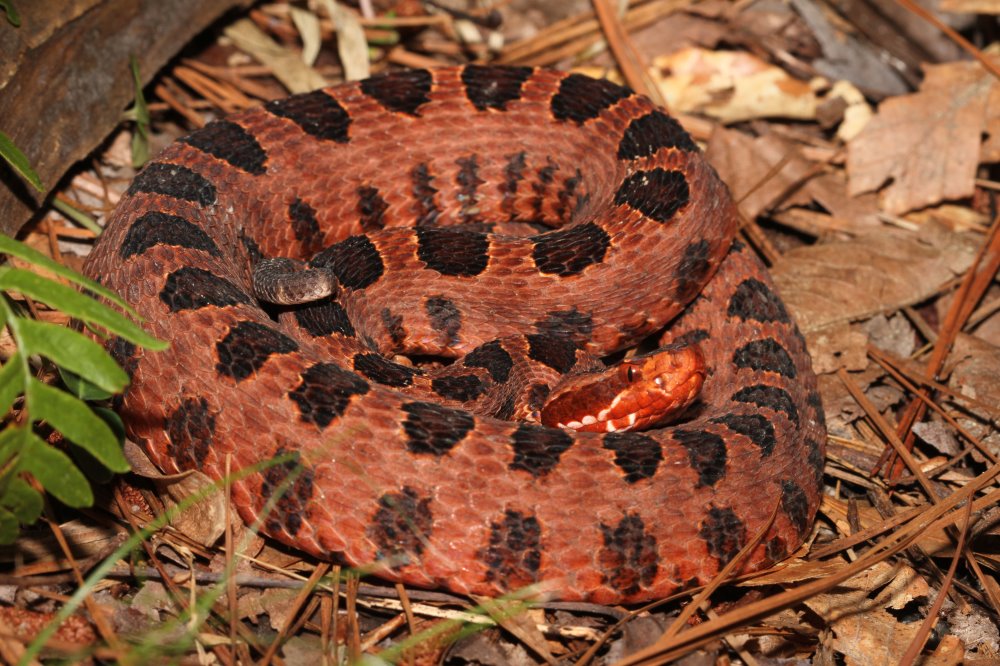
Yep! I sure do recognize red pygmys now!
The spring of 1953 was a long time ago, but it was then that Gordy Johnston took me on my first long distance herping trip. In his VW Beetle we traveled from MA to our destination of northeastern NC in just a few hours. I was entranced. Heat, humidity (not that at that time of year the heat and humidity is any stranger to New England), immense live oaks, more pine trees than I had ever seen before, and the possibility (read that probability!) of new herps (back then the words herps and herpetoculture had not yet been coined –right Philippe?).
I’m sure that we found may herps on that trip, but of these one in particular sticks in my mind—a red phase Carolina pygmy rattlesnake, Sistrurus m. miliarius. And the reason I remember it is because when I found it I had no idea what the little snake was.
Even back in those long ago days the woodlands were far from pristine. Logging, especially of pines, was big business. This seemed especially so on the Albemarle Peninsula and the vicinity of Lake Mattamuskeet. Itinerant sawmills were scattered here and there through the woodlands and wherever one of these sprang up clearings were begun, and like Topsy, they grew and grew as the trees were cut and cleaned (debarked and trimmed). Soon sunshine shone where before had been comparative darkness and the trimmings of the trees grew into piles of seclusion for many herps. At some point the sawmill packed up and moved, leaving behind the trimmings and the tin-roofed open shelter that had protected the machinery from the elements.
Gordy and I had happened upon one of these vacated mill locales and we were busily turning the tree trimmings when I turned up this little red snake. As surprised as I was, the little snake coiled and struck at my nearby hand. Hmmmmm.
“Gordy, I’ve got a baby copperhead here.”
Gordy hurried over and carefully edged the little snake into a gallon jar. We both stared. Its dark saddles on the orange-red ground entranced us—and even after staring at it and realizing that copperheads were usually banded, not saddled, when we left with it and a big kingsnake that also confused us (it was a red phase mole king, Lampropeltis calligaster rhombomaculata) it was with the thought that we had found a strange appearing copperhead.
It was not until we had returned home that a more knowledgeable friend looked at the snake and commented about the tailtip button that we realized we had actually found a pygmy rattler, a red one, a phase that we had had no idea existed. Ahhhhhhh—those good old days (no internet, very few books, and youth---learning could be a real challenge!
Continue reading "Our First Red Pygmy"
Friday, January 4 2019
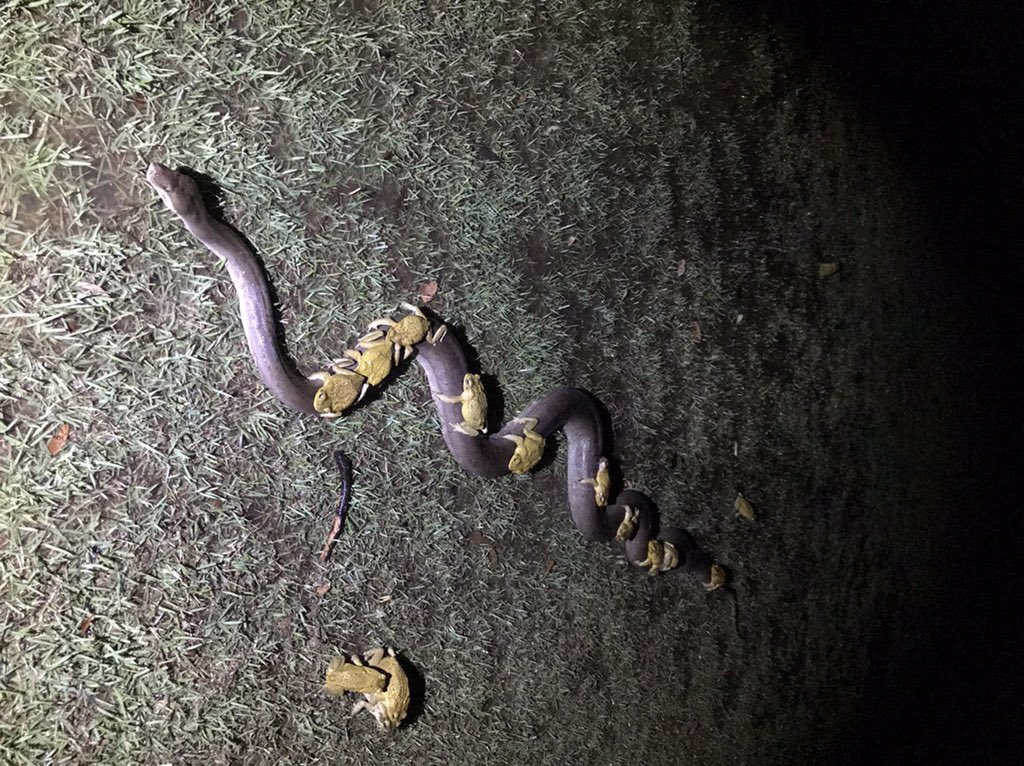
Several Cane Toads remind us that necessity is the mother of invention as they found a novel way to get out of an area being flooded by an overflowing dam. They hitched a Lyft, wait make that lift on the back of a local python named Monty. It is Australia after all, pythons just wander the streets there I hear!
"I went out and the lake had overflowed," he says, and realised the toads, who nested around its edge, were fleeing the rising waters.
"Thousands of toads were all trying to find somewhere to go," he says. "And then I saw Monty our local python with a bunch of hitchhikers on his back."
A variety of theories abound from it being staged to male toads with a little romantic confusion, but we just think it is a cool story! Check out the full story and video here!
Photo courtesy of Paul and Andrew Mock, originally shared at https://tinyurl.com/y8dzldea
What a gorgeous hybrid ( Crotalus mitchellii pyrrhus x stephensi) in our herp photo of the day uploaded by kingsnake.com user -SoloViper- ! If I were to give it a catchy name it would be Specklemint Rattlesnake. Be sure to tell them you liked it here!

Upload your own reptile and amphibian photos at gallery.kingsnake.com, and you could see them featured here!
Thursday, January 3 2019
If this axolotl in our Herp Photo of the day, uploaded by kingsnake.com user tadpoleo doesn't make you smile, I am not sure what will! Be sure to tell them you liked it here!

Upload your own reptile and amphibian photos photos at gallery.kingsnake.com, and you could see them featured here!
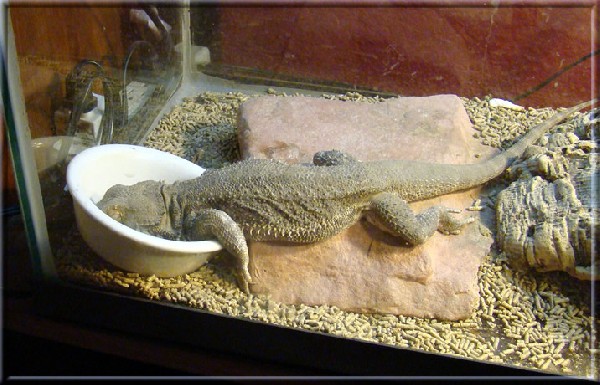
My very first bulk cricket order was from Jurassic Snacks in the early 90's.This was well before the internet, we herpers were still working on long distance calls and mail order lists. Everyone has that story, especially us old timers. After lamenting my issues of fitting the square box full of crickets into the rectangle aquarium to a friend, he let me in on the trash bag trick. This tale from a twitter user had tears coming from my eyes.
This tale from a new bearded dragon owner in Minnesota might very well be the funniest thing you have read this week.
Having never ordered internet crickets before, I naively assumed that I’d open up the box and find the crickets in some sort of sealed bag or other contraption to facilitate easy transfer to their final storage place. I also assumed that given the near-zero temperatures we were experiencing that morning, any crickets in the box would be groggy and disoriented and easy to manage.
I was wrong on both counts.
I have not lived in the home I received my first cricket order since 2000, but I am convinced the house still has crickets roaming the halls. To read the full story, I strongly suggest you click here.
Inset photo of post feeding beardie courtesy of TazziesMommy
Wednesday, January 2 2019
Love this shot from the field! Found on the UC Santa Cruz campus, this Black Salamander ( Aneides flavipunctatus) is getting a closer look at us in our Herp Photo of the day, uploaded by kingsnake.com user sc_shark ! Be sure to tell them you liked it here!

Upload your own reptile and amphibian photos at gallery.kingsnake.com, and you could see them featured here!
Tuesday, January 1 2019
Baby pictures never get old. Let's welcome this little ball python to the world in our Herp Photo of the day, uploaded by kingsnake.com user TerryHeuring brighten your day!! Be sure to tell them you liked it here!

Upload your own reptile and amphibian photos at gallery.kingsnake.com, and you could see them featured here!
|



